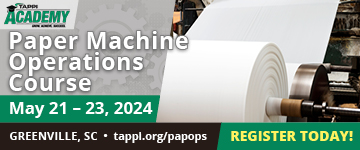 Search
Search
Use the search bar or filters below to find any TAPPI product or publication.
Filters
Content Type
Publications
Level of Knowledge
Collections
Journal articles

Nanotechnology Functionality in Flexible Packaging; New Methods of Manufacturing, The PLACE, December 2006
Nanotechnology Functionality in Flexible Packaging; New Methods of Manufacturing, The PLACE, December 2006
Journal articles

Nanotechnology is Ready to Transform Our Industry", Paper360º September/October 2013
Nanotechnology is Ready to Transform Our Industry, Paper360º September/October 2013
Journal articles

International cooperation needed for nano standardization, Paper360° July/August 2011
International cooperation needed for nano standardization, Paper360º July/August 2011
Journal articles

Magazine articles

TAPPI Journal Summaries, Paper360º September/October 2019
TAPPI Journal Summaries, Paper360º September/October 2019
Journal articles

Magazine articles

Understanding extensibility of paper: Role of fiber elongation and fiber bonding, TAPPI Journal March 2020
ABSTRACT: The tensile tests of individual bleached softwood kraft pulp fibers and sheets, as well as the micro-mechanical simulation of the fiber network, suggest that only a part of the elongation potential of individual fibers is utilized in the elongation of the sheet. The stress-strain curves of two actual individual pulp fibers and one mimicked classic stress-strain behavior of fiber were applied to a micromechanical simulation of random fiber networks. Both the experimental results and the micromechanical simulations indicated that fiber bonding has an important role not only in determining the strength but also the elongation of fiber networks. Additionally, the results indicate that the shape of the stress-strain curve of individual pulp fibers may have a significant influence on the shape of the stress-strain curve of a paper sheet. A large increase in elongation and strength of paper can be reached only by strengthening fiber-fiber bonding, as demonstrated by the experimental handsheets containing starch and cellulose microfibrils and by the micromechanical simulations. The key conclusion related to this investigation was that simulated uniform inter-fiber bond strength does not influence the shape of the stress-strain curve of the fiber network until the bonds fail, whereas the number of bonds has an influence on the activation of the fiber network and on the shape of the whole stress-strain curve.
Journal articles

Guest Editorial: Nanocellulose and the future, TAPPI JOURNAL May 2014
Guest Editorial: Nanocellulose and the future, TAPPI JOURNAL May 2014
Journal articles

Strong Aqueous Gels of Cellulose Nanofibers and Nanowhiskers Isolated from Softwood Flour, TAPPI JOURNAL February 2011
Strong Aqueous Gels of Cellulose Nanofibers and Nanowhiskers Isolated from Softwood Flour, TAPPI JOURNAL February 2011
Journal articles

Magazine articles

Novel CaCO3-polymer nanocomposite fillers for the improvemen
Novel CaCO3-polymer nanocomposite fillers for the improvement of bagasse-based papers, November 2016 TAPPI JOURNAL
Journal articles

Magazine articles

Degradation of 2,4-dichlorophenol by melamine amine cellulos
Degradation of 2,4-dichlorophenol by melamine amine cellulose- immobilized lacasses, TAPPI JOURNAL October 2017
Journal articles

Magazine articles

TAPPI Journal Summaries, Paper360º January/February 2017
TAPPI Journal Summaries, Paper360º January/February 2017






